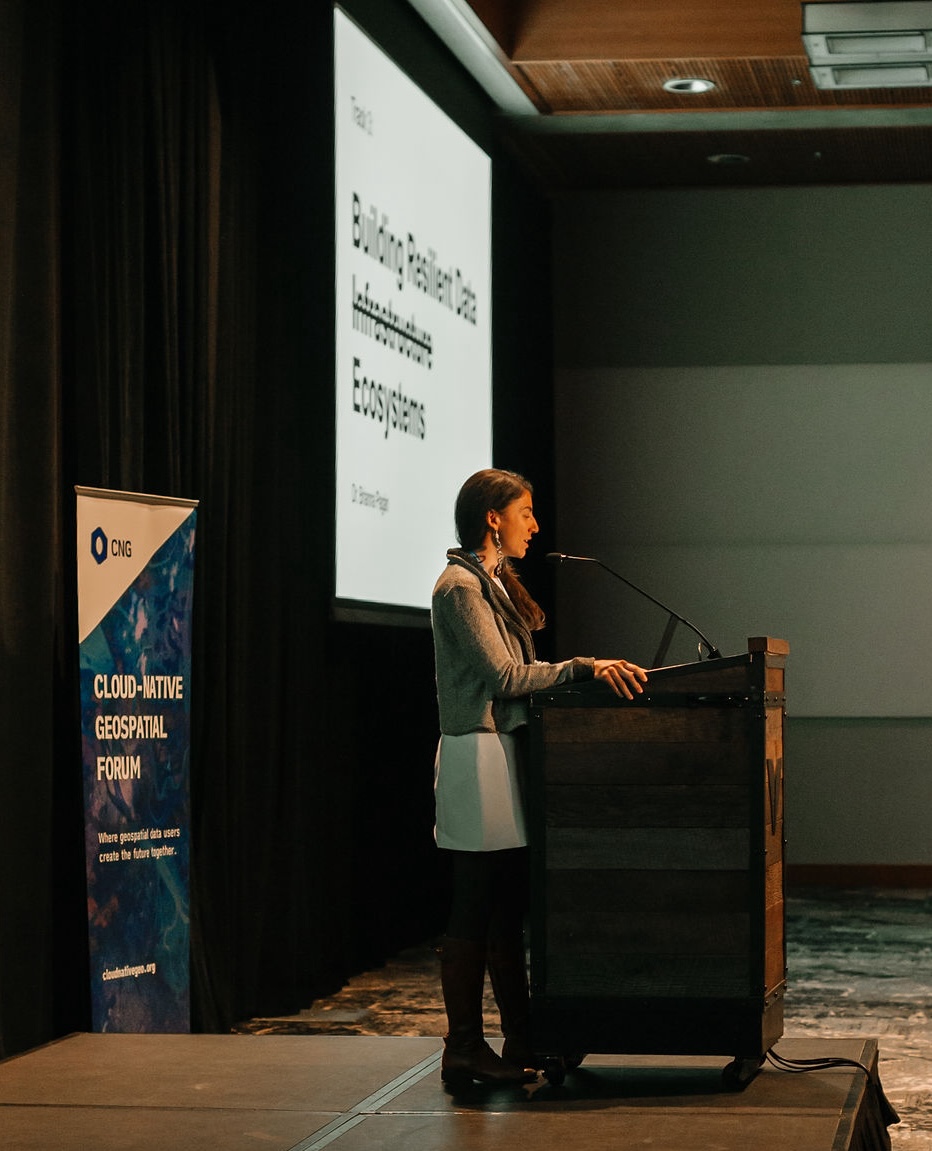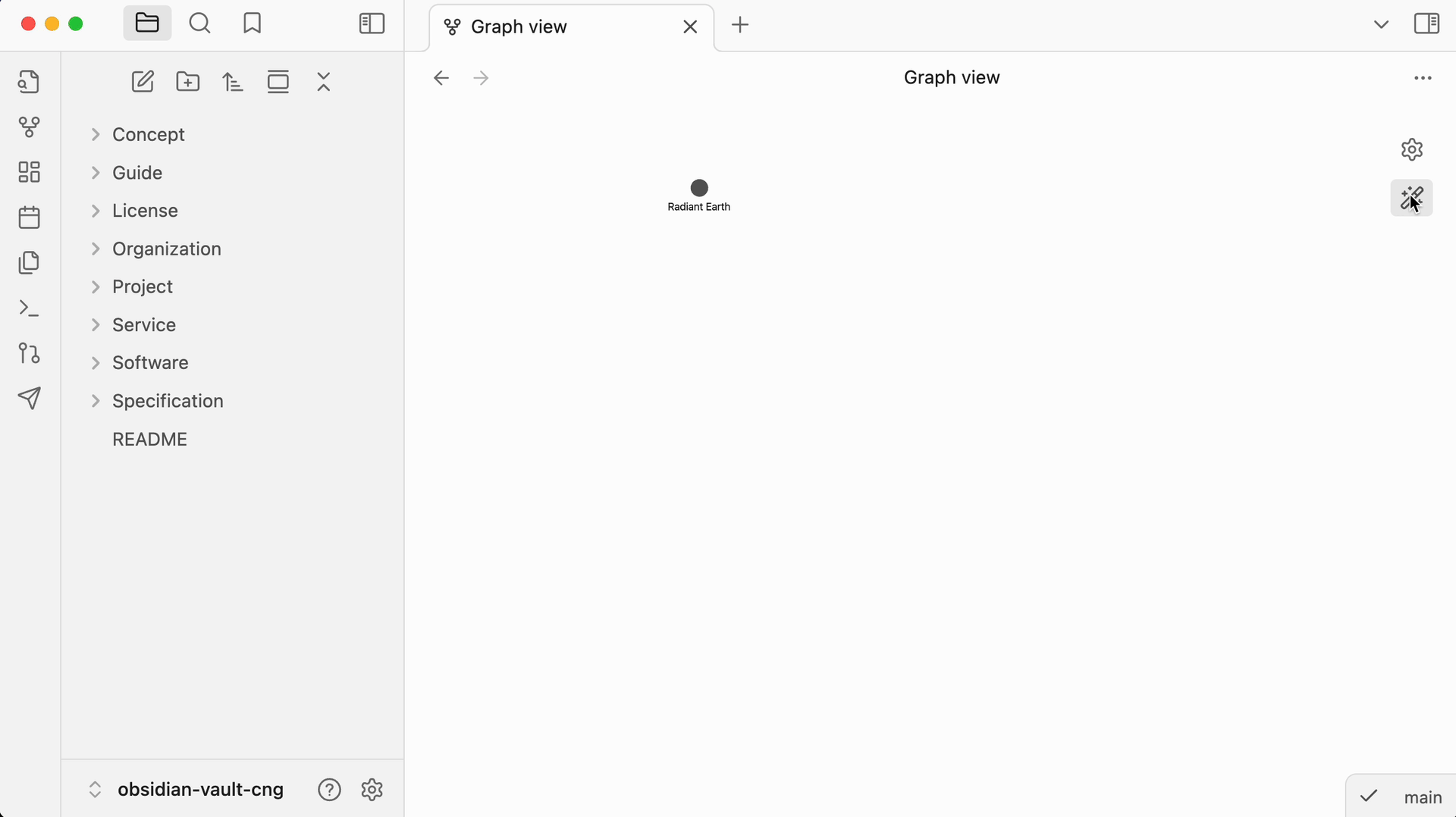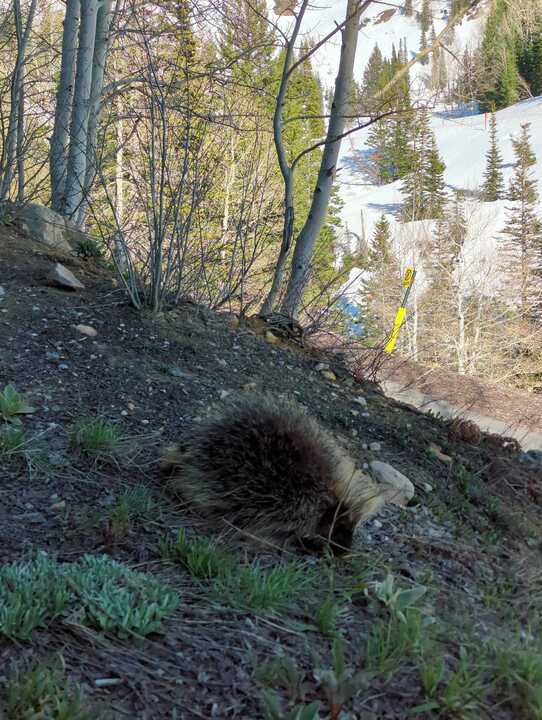Last week CNG Conference 2025, the inaugural in-person conference of the Cloud-Native Geospatial community, took place in Snowbird, Utah. The venue was beautiful, relatively affordable1, and just about the perfect size for a ~235 person event like this.
Overall, I thought it was one of the best events that I have ever attended!2
Below are some thoughts and takeaways from the event, from the perspective of someone who has planned and attended many geo-data conferences over the years, from >10 years of Google’s Geo for Good3 summits to the scrappy SatCamp4 gatherings.
Three Track Organization
The conference content was organized into three tracks, bookended by each day’s plenary morning session and a wrap-up session. The tracks allowed the community to self-organize into specialized areas of interest, while still being able to attend keynotes and have a shared community experience. While this is a fairly common format, what set this conference apart was the intentional design and execution of the tracks. Each track had a leader that planned out the content, gave a short talk on Day 1 providing context for the track, and gave a recap summarizing the track’s presentations at the end of Day 2. Thank you to the track leadersJulia, Aimee, and Brianna for your hard work, which made the content organized and accessible!
CNG as an Ecosystem
One of the high-level themes of the conference was the recognition of CNG as an ecosystem of data sources, open source software projects, commercial products, organizations and communities. This was a central point of Chris Holmes’ keynote which was an updated take/pivot on his FOSS4G NA 2023 keynote calling for building spatial data infrastructure (SDI). I certainly prefer the ground-up evolving ecosystem view as compared to the top-down imposed infrastructure view, particularly in light of how the CNG community operates and what will be most resilient to the present corporate and government changes and instability.
Brianna continued this theme by renaming Track 3 to Building Resilient Geospatial Infrastructure Ecosystems. I spent most of my time attending sessions in this track, mainly because of the topic, but also because it was the one track that was intentionally not recorded. The sessions featured Chatham House rule-style inclusive and open discussions. There was great (and unexpected?) interest in this track5 and Brianna and Ankur did a great job adapting the discussions to be inclusive in light of the increased number of participants.
(source: Cloud Native Geospatial Forum, photographer: IZ Merrill, license: CC BY-SA 4.0)
In my own talk, I tried to capture the complexity of trying to learn about components of the CNG ecosystem in a visual way, by documenting the components and their interrelationships.
(source: Tyler Erickson, license: CC BY 4.0)
click to expand image
Lightning Talks
My main contribution to the conference was organizing and emceeing the lightning talks. I was impressed with the quality of the talks, both for those who prepared far in advance and those who quickly put together a talk on short notice6.
We used the Ignite-style format, where each presenter has 5 minutes to present their talk, consisting of 20 slides that automatically advance every 15 seconds. Both the audience and the presenters seemed to enjoy the format. I like it because it shares a large amount of content in a short amount of time, is entertaining, and invites follow-up conversations with the presenters7.
Recording
Thankfully two of the three tracks and the plenary room content were recorded, so we can look forward to watching the content as it is released. There were so many interesting presentations/workshops happening concurrently. I even ended up missing two of the three keynotes because of being in interesting conversations that I didn’t want to end. I wish more conferences would take this approach of recording and sharing the content… it is beneficial for the both the attendees who can’t be in multiple places at once and for those who couldn’t attend the conference for whatever reason. While it could potentially depress the in-person attendance numbers, I don’t think that should be a significant concern for events like this, where the main value of in-person attendance is in making connections with other attendees.
Zarr is taking off
Throughout the event there was a lot of interest in Zarr and excitement about its potential. It was great to see smaller organizations trying Zarr out, kicking the tires, and reporting out to the community. I particularly liked the honest assessment by Sarah Zwiep from Floodbase about their experience in evaluating Zarr for their use case.
On the other hand, it’s a bit concerning to see how quickly large data providers like ESA and NASA seem to be moving toward adopting Zarr in the context of satellite scenes/images, given that the spec and tooling are still rapidly evolving. If you have interest/concerns in this area, please join the current GeoZarr spec discussions. The upcoming year could be both interesting and rocky for Zarr adoption…
Maintaining the momentum
The third day was a bit more focused on community building, identifying gaps, and building consensus on what the community should focus on next. Ankur led a large group exercise in the main room, involving brainstorming, small group consensus, and summarizing the thoughts of the whole group. It’s hard to fully describe the experience… but I especially enjoyed the ~5 minutes of near total silence (amazing!) as we organized into our groups of five.
This is the second time that I have witnessed Ankur’s presence and facilitation magic, but this time with 10x more people.
In terms of identifying gaps, it was great to see that there was consensus on the need to improve both CNG educational content, and in the infrastructure needed to collaboratively develop and maintain such content. That is a gap that has been bothering me for quite a while. Too often those building the tech get caught up in building ever more shiny new features and benchmarks, and it is easy for the hard work of effectively communicating with and educating potential users of the existing technology to be ignored. Not only do we need to get better at educating hands-on users, but we need to build awareness beyond our current, relatively small, community by sharing more tangible success stories.
We left the conference with list of priority focus areas, new connections, and a new set of Slack channels8 to keep the conversation going. will tell if the excitement will continue post conference, but the energy was high and I am hopeful.
Is a future CNG conference right for you?
There is no shortage of conference options for geospatial professionals, and many of them offer opportunities for learning and networking. So here is a quick comparison of CNG compared to other events, from small to large:
SatCamp - This is an annual three day gathering of ~70 geospatial folks in the outdoors which started in 2023. The focus is on networking, brainstorming, and collaboration building, with relatively little time devoted to presentations. Choose this if you value networking above all else. (I love this event, but I’m biased since I help organize it.)
SatSummit - SatSummit is the parent(?) of SatCamp. It started in 2015 in Washington, D.C. but has since expanded to Lisbon, Portugal. It typically is a 2-day event, with a focus on applying Earth data to address global development problems. Choose this if you focus on the intersection of technology and global development.
EO Summit - This is a two-day gathering, focused on Earth Observation applications across a range of industries. It started in 2024 and the upcoming event (NYC, June 2025) is expected to draw ~500 attendees. Choose the EO Summit if you are interested in business applications of Earth observation.9
Living Planet Symposium (LPS) - ESA’s conference on Earth Observation, held every three years. It attracts ~5,000 participants. It’s a great conference for those involved in remote sensing and Earth observation, but would have limited appeal for those outside that community or for those focused on non-ESA data sources. Choose LPS if you are want to stay up to date on ESA data and services.
EGU & AGU - Both the EGU General Assembly and AGU Fall Meeting are large10, well-established conferences with a diverse set of content and attendees. It’s easy to get lost, especially if you are starting out in your career. There are sections that involve geospatial data (EGU ESSI, AGU ESSI), but it is a small fraction of the overall content. Choose EGU or AGU if you want a more academic conference experience.
It all depends on what you want to get out of an event. I tend to prefer smaller events where there is ample time for repeated conversations over several days.
Miscellanea
I had a few unexpected happenings and learnings from the conference:
Many of the ski scenes for the 80’s classic comedy/romance Better Off Dead were filmed at Snowbird or in the surrounding area.
I learned details about LIDAR and soil organic carbon from interesting conversations that I didn’t expect to have.
It felt like 10-20% of the conference attendees were either coming from or heading to the Utah desert after the conference. The location was a great draw for those interested in outdoor activities.
And finally, thank you to Larry the porcupine for sharing his home with us.
Footnotes
It was near the end of Snowbird’s ski season. Still plenty of snow but melting fast!↩︎
Disclaimer: I admittedly may be a bit biased, since I helped in the early planning stages, emceed the lightning talks, and was one of the presenters.↩︎
Geo for Good started as an academic-style gathering and slowly transformed into a full-production corporate event.↩︎
SatCamp is outdoor networking for geospatial enthusiasts, now in its 3rd year.↩︎
Track 3 sessions were usually standing room only until we brought in more chairs!↩︎
One talk may have been created while the author was running around Zion National Park.↩︎
Follow up conversations can be encouraged by having a social hour immediately following the lightning talks, which we did.↩︎
Who doesn’t need another Slack channel?↩︎
The EO Summit is the only conference that I haven’t yet attended, but its application-focus looks interesting so I am including it here.↩︎
EGU attracts ~20,000 while AGU attracts ~25,000↩︎




